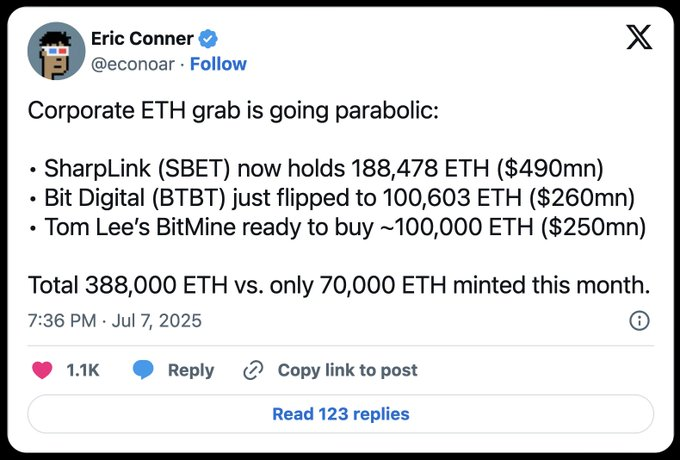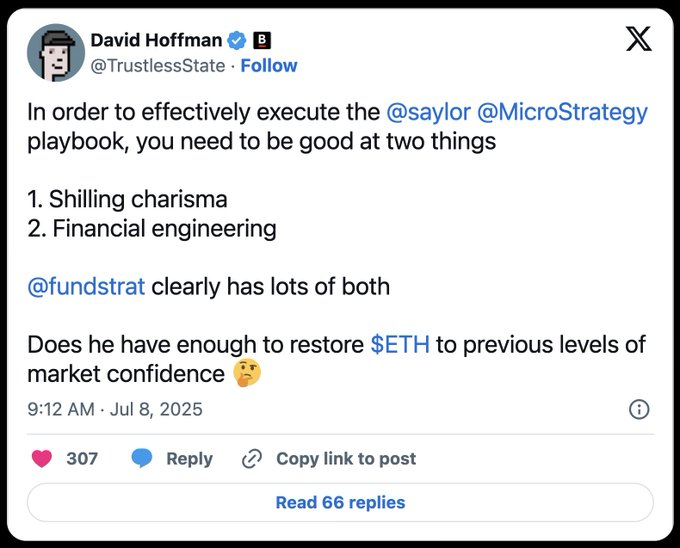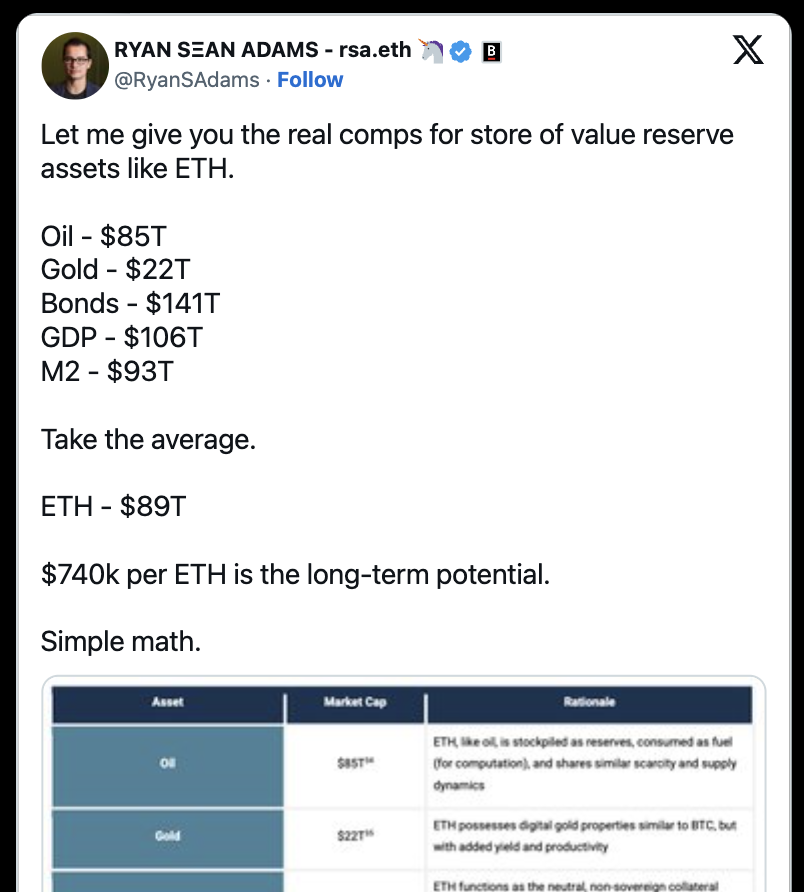Author: David Hoffman
Translated by: TechFlow
Ethereum is Winning, but ETH Investors Are Not
You may have noticed that my stance on ETH has become more moderate recently. The decline in ETH's relative valuation has led to a loss of investor confidence, which is crucial when ETH aspires to be the internet's currency.
The reasons for ETH's underperformance over the years have been a point of contention. Many issues troubling ETH's relative valuation are beyond its control - contributions from figures like Gary Gensler and Michael Saylor. (Gensler has left, and ETH investment management companies have finally been established; some external issues will resolve themselves.)
Today, I want to focus on challenges firmly within the Ethereum community's control, as many reasons for Ethereum's market underperformance over the past three years were community-determined. We should concentrate on addressing these issues to reinvigorate potential ETH buyers.
ETH's Value Capture Problem
Many challenges Ethereum faces can be distilled to one core theme: a broken value capture supply chain between Ethereum's utility and ETH's value.
"I'm surprised... the stablecoin usage on Ethereum, Solana, Tron... seemingly doesn't create more value for the Layer1 token holders these stablecoins depend on."
— Joe Weisenthal on The Chopping Block

In this episode, the CB team continued discussing this Ethereum-specific issue, as SOL and TRX have hit all-time highs, and Ethereum's economic model appears particularly flawed compared to competitors, especially with its Layer2 model.
Regarding stablecoins, concerns about the relationship between stablecoin supply and Layer1 token value capture emerged as early as the 2018-2019 bear market. Nic Carter discussed this in a 2020 Bankless article - Crypto Fiat: Mutualistic or Parasitic?
In short, stablecoin buyers and holders on Ethereum's Layer1 bring no value to ETH beyond spending about $0.50 in gas fees to purchase these stablecoins. If they do this on Layer2, ETH's value capture drops to below $0.01, even when purchasing billions of dollars worth of stablecoins.
Ethereum's Narrative Momentum
Nevertheless, Ethereum's adoption metrics are undoubtedly bullish.
The recent launch of Robinhood Chain deploying tokenized stocks on Ethereum validates Ethereum's Layer2 roadmap and its position as a credibly neutral settlement layer for Wall Street assets. With Robinhood Chain, OG promises blockchain technology will upgrade Wall Street's outdated financial system for tokenization and trading, and everything is happening.
This announcement is just one of many bullish signals for the network:
The Ethereum ecosystem maintains 50% dominance of stablecoin supply, which rises to 75% if you ignore the opaque Tron ecosystem.
CRCL's sensational IPO particularly validates Ethereum, as Ethereum holds 66% of all USDC.
Coinbase, the most trusted and respected brand in crypto, is building an Ethereum Layer2.
Ethereum's 100% uptime, prioritizing true decentralization without any counterparty, resonates to satisfy Wall Street's needs and enhance its brand image against competitors.
The economic influence of the ETH investment company is continuously strengthening:
Original tweet link: Click here

If you want to promote bullish arguments for ETH and Ethereum, it's becoming increasingly easier to do so.
All efforts by Ethereum developers to maintain decentralization and credible neutrality are being rewarded, with adoption metrics in the world's capital gravity center - Wall Street - being incredible.
Expanding ETH's Narrative
Many see opportunities in these adoption and success cases.
Tom Lee's Bitmine investment management strategy is leveraging Ethereum's narrative advantages. The strategy is simple: incorporate ETH into the balance sheet, then sell ETH to Wall Street. Ethereum itself has many narrative highlights; ETH only needs someone vibrant enough to excite Wall Street.

We are about to witness how undervalued ETH has been over the past four years. Is ETH's poor price performance due to market irrationality? Or does its decline truly reflect deeper, more structural issues?
Tribalism and Social Scalability
Diving deeper into the above, you'll gain more insight into two aspects of ETH.
On one hand, a network adopting a Layer2 model cuts a link in ETH's value capture supply chain. But on the other hand, you'll see an incredible success story that seems like ETH could reach $10,000 with just a gentle push from Wall Street.
My perspective on this dichotomy is as follows:
If you add narrative firepower to an unresolved value capture supply chain, you get tribalism that is loved within the tribe but rejected by those outside:
Original tweet link: Click here

Now, most people within Ethereum would be excited to see Ryan's proposed $740,000 per ETH price, while those outside Ethereum might view the same thing as delusional (just read the QT).
But let's imagine an alternative scenario where ETH's superior value capture supply chain becomes the core of the ETH narrative, like in 2021. In this scenario, all Ethereum Layer2s are based on Native+Based Rollup, with Ethereum's block time reduced to around 2 seconds (a long-term Ethereum goal).
In this world:
Rollups have synchronous composability, eliminating the need for network bridging. Lower Layer1 block times allow market makers to provide tighter spreads, driving more on-chain trading volume. Price execution significantly improves.
Ethereum's powerful MEV infrastructure can finally be used to provide best execution for traders (on Memecoin, etc.), instead of the approximately 20% yield they find elsewhere.
Cross-chain liquidity flows back to Layer1, with Native+Based Rollups seamlessly accessing Layer1 liquidity, increasing trading volume.
Based+Native Rollups consume 10 to 100 times more gas than current L2s, while providing shared liquidity and composability, meaning all this activity on Rollups actually consumes significant ETH.
Tokenized assets on Rollups will be accessible to other parts of the Ethereum ecosystem. Ethereum's position as a platform for tokenized asset issuance and trading will be further enhanced.
What I've outlined above is a future where: the utility of Ethereum and the feedback loop of ETH value capture will be restored.
Original tweet link: Click here
Breaking the Tribalism Narrative
In 2024, Bitcoin transformed from an asset primarily promoted by its tribal community to an asset viewed as a "special snowflake" by the world's most powerful governments. Only Bitcoin possesses strategic reserves. No other asset has such reserves.
Bitcoin's fundamentals (a 21 million cap) compel non-tribal investors to own at least some Bitcoin.
ETH needs to do the same thing.
While Tom Lee and all other ETH investment firms are spreading the gospel of ETH to Wall Street, it would be better if they could stand on a coherent value capture story and use it as leverage.
The Ethereum community must quickly repair the feedback loop between Ethereum's utility and ETH's value. We understand the necessary inputs. We also understand the stakeholders, including many who are already involved in realizing this vision, and some who may need to be convinced by other community members. We believe we can achieve this goal.
What are the stakes? It's a more effective Ethereum growth story that we can sell to the world—one that ultimately achieves the ETH tribe's expectations for ETH: breaking through the $10,000 price barrier.






